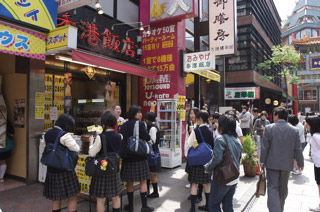Yokohama's Chinatown is the largest in Japan and dates back to the Opening of Japan in 1859. These days it's unabashedly touristy, but there are plenty of Chinese grocery stores and places to buy a cheap cheongsam dress or jade knick-knacks.
In 1859, When the sea port opened in Yokohama, many Chinese and European immigrants arrived in Japan and formed a foreign settlement. Later ferry services between Yokohama and Shanghai and Hong Kong were started. Many Chinese traders came to Japan and built a Chinese School, Chinese Community Center and various other facilities in what represented the beginning of Chinatown. However, government regulations at the time meant that immigrants were not permitted to live outside of the designated foreign settlement area. In 1899, changing laws gave Chinese increased freedom of movement while reinforcing strict rules on the types of work Chinese people were allowed to carry out.
In 1923, the Kanto Area was devastated by the Great Kanto Earthquake. Around 100,000 people were killed and approximately 1.9 million people became homeless. Chinatown also suffered and with many immigrants choosing to return to China instead of rebuilding their livelihoods in Yokohama.
For Chinese food the obvious choice is Chinatown, which has over 200 Chinese restaurants. Snacks are sold on the streets, but most restaurants in the area are quite expensive (expect to pay \1,500 for a decent lunch) and the food has been toned down to suit the Japanese palate. One of the most popular foods in Chinatown is Nikuman (肉まん nikuman), or bread filled with pork and vegetables, which are sold by dozens of stores and vendors. Chinatown is the terminus of the Minato Mirai 21 line.
(reference: Wikipedia, Wikitravel)






